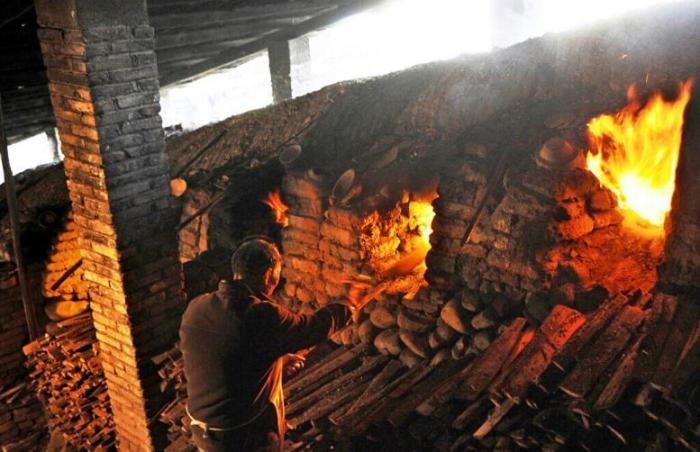In China, the art of Ceramics is known as the art of “clay and fire”. That’s not a surprise, knowing that the kiln is a critical piece of equipment for firing ceramics. The most fascinating kind of kiln is without doubt the Chinese dragon kilns (long yao 龙窑). It’s a traditional form of kiln before industrial ovens existed. Even today, such a kiln produces still superior, unrivalled quality ceramics. Now is a good time to further understand the meaning, history and workings of such a kiln, given that Teasenz recently launched a dragon kiln fired Yixing tea pot.
Dragon Kiln Meaning
You may wonder: how did it get the name “dragon” kiln? First, it is cylinder-shaped and long. Most of the dragon kilns were built on sloping hillsides and were between 30-80 metres in length. Secondly, the kiln has 10-20 degrees angle and has a low front (head) and a high end (tail), resembling a dragon swooping downwards.
The height difference between the front and the end of the kiln creates a draw, which makes the kiln naturally ventilated so it can be built without a chimney at the end.
Dragon Kiln History And Development
Dragon kilns first appeared in the Shang Dynasty (1600-1046 BC). They were then commonly used in the Warring States period (475-221 BC), and were improved in the Eastern Han Dynasty, and later widely used in the southern areas such as Jiangsu, Zhejiang, Guangdong, Fujian, Jiangxi and Hunan.
Early dragon kilns were generally a dozen to 20 metres long, and by the Song Dynasty they were as long as 50 to 60 metres, in some areas even reaching 70 to 80 metres, and could fire 20,000 pieces of ceramics at a time, playing a large role in the development of ceramics. The number of dragon kilns gradually increased, and the inclination and structure of each dynasty also continued to improve, so that the firing effect of dragon kilns was perfected.
During the Song and Yuan dynasties, a kind of dragon kilns was built with multiple fire-blocking walls inside the kiln, which split it into a number of small chambers, with smoke and fire holes in the lower part of the fire-blocking walls, so that the chambers were connected to each other, that is a “chambered dragon kiln”.
Dragon kilns powered by pine and cypress wood. The majority of today’s ceramic firing is largely replaced by electric, oil and gas kilns.
Dragon kiln Characteristics
In the past Dragon kilns were the most popular type of kiln. They are characterised by fast heating and cooling, short production cycles, large firing area, high output and low firing costs.
However, the kiln is simple in structure and not easily mechanised, which means intensive labour in loading and discharging the kiln.
As it could fire quickly and also maintain the reduction flame for firing celadon, the dragon kiln was named “cradle of celadon”. The majority of the shadow blue and black-glazed porcelain was also fired in the dragon kilns. In a sense, dragon kilns played a big role in the development of ceramic ware in ancient China.
Many years ago, industry specialists were certain that Dragon Kilns would disappear soon due to higher labour costs and relative low efficiency relative to industrial ovens. However, industrial ovens don’t produce the same result. For example, Yixing teapots fired in dragon kilns have a more oily and glossy surface that some tea enthousiasts can appreciate. It said, it’s not necessarily better or worse, it’s just a different result that some teapot collectors prefer Ceramics made in Dragon Kilns are therefore still very much sought for today. There’s absolutely no sign that they disappear any time soon.
The Oldest Working Dragon Kilns
There are two world’s oldest wood-fired dragon kilns, known as “living fossil of ceramics”. One is in the town of Zisha clay – Yixing, the other is located in Southern ceramic capital Foshan, Guangdong. Both built 500 years ago during the Ming Dynasty, these kilns are still firing today and part of key conservation sites.

The kiln in Yixing is called Qianshu Dragon Kiln, named after the village it is located. It is the most ancient kiln in the world for firing Zisha clay ware.
The Foshan kiln is called Nanfeng Guzao (South Wind Dragon Kiln). The reason for this is that the entrance to the kiln faces the south, and whenever the kiln is lit, the wind from the south will enter through the opening, making it easy for the fire to flourish.
Discover more from Hello Tea Cup
Subscribe to get the latest posts sent to your email.







4 Comments
Michellee
May 30, 2021 at 9:08 pmHow long does the dragon kiln take before the ceramics inside are ready?
teasenz
September 13, 2021 at 10:07 amThis depends on many factors including: the type of clay, size and thickness of the ceramic, and the temperature applied. Pieces that require similar time are often grouped together for baking.
Natasja
May 30, 2021 at 9:09 pmHow is the dragon kiln powered?
teasenz
September 13, 2021 at 10:06 amIt’s powered by firing wood.